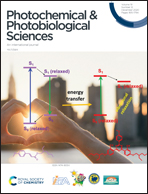A rhodamine-based dual chemosensor for the naked-eye detection of Hg2+ and enhancement of the fluorescence emission for Fe3+†
Abstract
A novel fluorescent chemosensor based on trimesoyl chloride–rhodamine (TR) was successfully synthesized. Rising chromogenic and fluorogenic spectral enhancements could be observed in trimesoyl chloride–rhodamine (TR) probes when Hg2+ and Fe3+ were added, respectively. TR has shown selectivity for Hg2+ and Fe3+ with high sensitivity due to metal ion complexation induced photophysical “turn-on” signaling responses. The detection limit towards Hg2+ was 2.46 × 10−8 M as determined by the 3σ method. At the same time, fluorogenic spectral enhancements were observed in TR, which exhibits a superior sensitive and selective recognition towards Fe3+ with 4.11 × 10−8 M of the detection limit. The test strips were used for colorimetric and simple detection towards Hg2+, which might finally enable the advancement of the Hg2+ sensor in the field of on-site detection.



 Please wait while we load your content...
Please wait while we load your content...